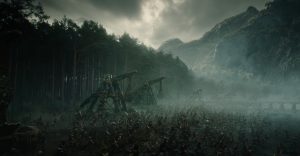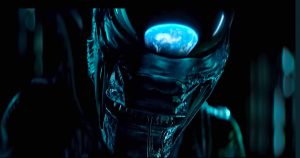
Doctor Who has a habit of taking a throwaway line and making it into a big deal.
In 60th anniversary special “Wild Blue Yonder”, Russell T. Davies wrote what seemed like a passing joke about Isaac Newton mishearing the word ″gravity″ as “mavity” before committing to the bit and changing the word in the timeline from that point onwards, making the gag not so inconsequential after all.
Mavity isn’t alone in the show’s history. Throwaway lines have been seized upon and expanded over the years, some by the show’s fandom, but also by its writers. What started as world-building, texture or a dramatic beat has become the foundation for a whole new level of storytelling.
Lines like these…
“The heart of the machine is under the column”
The Edge of Destruction (1964), written by David Whitaker
In this First Doctor story, set almost entirely inside the TARDIS, a series of strange events makes everyone tense and agitated. Come the finale, as the Doctor announces they’re on the brink of destruction, Barbara realises something. The ship, the TARDIS itself, has been giving them clues. That’s what the strange events have been.
The Doctor, interestingly, insists that the TARDIS cannot think, but states that its power source is beneath the central column on the console. The idea of the TARDIS being sentient, and the importance of its power source beneath the console, are developed further in the post-2005 series (especially Neil Gaiman’s ‘The Doctor’s Wife’) and becomes a crucial plot point at the end of series one (in both ‘Boom Town’ and ‘The Parting of the Ways’).
“No, they have been recognised on Planet 14”
The Invasion (1968), written by Derrick Sherwin
Tobias Vaughn, head of an electronics company, is helping the Cybermen invade Earth. Talking to a Cyber-Planner (a computer-brain with a gift for strategy), they look at security photos of the Second Doctor and Jamie. The Planner recognises them from “Planet 14”, which makes Vaughn question how they could have been on another planet.
Viewers with good memories might have been watching this in 1968 and thinking ‘Hang on…when were they on Planet 14?’, because this was the first anyone had heard of it. Given the Doctor and Jamie had met the Cybermen onscreen three times at this point, the fact that Derrick Sherwin gave them another encounter has led writers to try to fill in the gaps, notably Grant Morrison in their 1987 comic strip ‘The World Shapers’ and Steven Moffat in ‘The Doctor Falls’, where he suggests parallel evolution of different Cybermen, making them adherents of a repeated meme.
“I was there at the fall of Arcadia”
Doomsday (2006), written by Russell T. Davies
The Time War was, of course, much more interesting as an imagined horror than as depicted events. Now we have endless reiterations of the story structure ‘I’m Not the Doctor > Meets Surrogate Companion > The Time Lords are Dicks > Surrogate Companion Dies > I’m Not the Doctor Really I Hate War’ across different mediums. Before this, though, we had Russell T. Davies dropping in colossal-sounding events and concepts without offering any details. The Time War was in the mind’s eye of the beholder. What was “The Could’ve Been King”? The “Horde of Travesties”? The “Skaro Degradations”?
When the Tenth Doctor says he fought on the front lines and was present at the fall of Arcadia, we didn’t know what that truly meant until ‘The Day of the Doctor’ in 2013: Arcadia is Gallifrey’s second city. Steven Moffat took Davies’ line and built on it: if Gallifrey is destroyed, what does that mean beyond some dusty archivists in stupid collars disappearing from the show? Arcadia is Gallifrey’s second city. We get more of a sense of the planet, rather than just the Capitol. And this allows Moffat to show the people of Gallifrey, notably the children. Billions of lives, rather than a small group of politicians, are at stake.
“And didn’t we have trouble with the prototype?”
Remembrance of the Daleks (1988), written by Ben Aaronovitch
This is disguised as a throwaway line, but was meant to be the start of an exploration of the Doctor’s identity that culminated in a retcon revealing the Doctor to be an influential figure in the origins of Gallifrey (if you can imagine such a thing).
Barring a few hints, this never made it onscreen, but it was occasionally dabbled in during the New Adventures book line in the Nineties. The final Seventh Doctor novel was ‘Lungbarrow’ by Marc Platt, originally pitched for television: a mix of Mervyn Peake and Lewis Carroll set in the Doctor’s family home which, despite being disregarded in terms of canon, looms over the series as a spectral alternative history.
“Ah, that’s the Blinovitch limitation effect”
Day of the Daleks (1973), written by Louis Marks
A story featuring a temporal paradox, as a group of guerillas from the future try to travel back in time to prevent World War Three from happening and thus making the Earth susceptible to Dalek invasion. Unfortunately their presence reinforces the original timeline rather than altering it, until Jon Pertwee’s Doctor intervenes.
‘The Blinovitch Limitation Effect’ dialogue was added – with no further explanatory dialogue – to quickly establish that the guerillas couldn’t just keep travelling back in time to have another go at changing history. This quick handwaving away of a potential plot hole was taken up by the series, being directly referenced again in ‘Mawdryn Undead’ and ‘Kill the Moon’, and so it explains why time travellers don’t simply just travel back to the same spot over and over again to solve things and why two versions of the same person shouldn’t touch (except when characters do do these things, in which case presumably there’s another phenomena called The Blinovitch Limitation Effect Limitation Effect).
“It can’t be. I’m from 1980”
Pyramids of Mars (1975), written by Robert Holmes
The Fourth Doctor and Sarah are fighting Sutekh, a godlike being of immense power, in 1911. Sarah points out that they could just leave, because they know the world doesn’t end in 1911. The Doctor takes her to 1980 and shows her “a desolate planet circling a dead sun”.
This detour not only shows us the consequences of the Doctor failing to save the day (and the fluidity of time away from fixed points) it also plays a small but potent role in that great clusterfuck of nonsense: The UNIT Dating Controversy.
Essentially, UNIT seemed to be from the late Seventies. The Doctor meets the Brigadier in 1975 at the earliest, and then their next meeting is – from the Brig’s point of view – four years later. This means ‘The Invasion’ takes place in 1979 at the earliest.
Then we have the five series with the Third Doctor where UNIT feature regularly, with Sarah Jane arriving during the last of these (although wisely Script Editor Terrance Dicks doesn’t offer any indication of dates or timeframe during these stories to avoid precisely this sort of thing from happening). Sarah stating that she’s from 1980 implies that everything we see in the Pertwee era takes place in less than a year in real time. In which case, what a year.
The best bit is this isn’t even the biggest problem with the UNIT timeline! If you want to know more, go and watch ‘Mawdryn Undead’ and get back to me.
“You can’t kill illusions”
The Five Doctors (1983), written by Terrance Dicks
On the face of it, this is a haunting scene where the Second Doctor and the Brigadier meet phantom versions of companions Jamie and Zoe. The Doctor realises they’re illusions because they’re older than when we last saw them, and Jamie and Zoe had their minds wiped of their time on board the TARDIS, right before the Second Doctor was forced to regenerate (all in 1969’s ‘The War Games’). How, then, is the Second Doctor here with this knowledge? There is no obvious onscreen gap where he could disappear off to visit the Brigadier (as he does at the start of ‘The Five Doctors’) before ending up back on Gallifrey.
This, and other continuity problems, inspired the ‘Season 6B’ theory in the book The DisContinuity Guide by Paul Cornell, Martin Day and Keith Topping: that the Second Doctor doesn’t regenerate at the end of the War Games, but instead ended up working for the…
“Celestial Intervention Agency”
The Deadly Assassin (1976), written by Robert Holmes
The Doctor returns to Gallifrey and the guards immediately try to arrest him. The Castellan (essentially the head of police) asks for more information on the Doctor, and is told about his previous trial in ‘The War Games’:
Co-ordinator Engin: I see there is an addendum. Ah, yes. The sentence was subsequently remitted at the intercession of the CIA.
Castellan: Celestial Intervention Agency. They get their fingers into everything. Is he mixed up with them?
Engin: There’s nothing further on the file.
Castellan: Oh yes, they’d see to it that there wouldn’t be.
Robert Holmes wrote this as a gag, and nothing more. And yet the CIA has endured as a concept, even if it is a little busy in the secret Gallifreyan interventionist group arena these days, to the extent that it was included as a key part of the Season 6B explanation that appeared on the (now archived) Doctor Who website.
“Even the silent gas dirigibles of the Hoothi are felt in our bones while still a million miles distant”
The Brain of Morbius (1976), written by Robert Holmes and Terrance Dicks
Robert Holmes rewrote Terrance Dicks’ scripts for this story, demonstrating his ability to expand universes with apparently throwaway dialogue. Holmes’ worldbuilding was peerless, slipping enough details into dialogue to suggest something much larger than what we saw or focussed on onscreen. This example – spoken by Maren, the leader of the Sisterhood of Karn, in response to news that the Doctor and Sarah have arrived on the planet without their knowledge – is in the script simply to demonstrate the Sisterhood’s power, but it would be built on years later by Paul Cornell in his 1992 novel ‘Love and War’.
In the novel, Cornell takes this line and turns the Hoothi into a formidable monster: a fungal hive-mind who could infect life-forms with their spores and absorb them into their consciousness. To counteract this, the Doctor has to be at his most ruthless. From this one line Cornell gives a cause for the darker characterisation of the Doctor, established during the final season of the original run, to go as far as it possibly can.
“The point is not whether you understand. What is going to happen to you, hmm? They’ll tell everybody about the ship now.”
An Unearthly Child (1963), written by Anthony Coburn
Less a throwaway line picked up in later stories, this one transformed the Doctor’s character right from the off. Back in Doctor Who’s very first episode, schoolteachers Ian and Barbara are unnerved and intrigued by their pupil Susan Foreman and, er, follow her home. No getting around it, that’s a strange choice. They see her enter a junkyard, and find a strange old man with a strange blue box. Hearing Susan’s voice they barge in, and discover an impossibly large white control room. The Doctor, for it is he, mocks their lack of comprehension and then asks the most important question in the show’s history – not ‘Doctor Who?’, but ‘What is going to happen to you?’
In context it’s more of a threat, a worry. The Doctor doesn’t want to be discovered, and realises that if he lets the teachers go he and Susan will have to leave. So, establishing a character trait early, he makes a decision for everyone else without telling them and sets the ship in flight, kidnapping Ian and Barbara.
And thus, everyone’s favourite family TV show was born.
The post ‘I Was There at the Fall of Arcadia’ and Other Throwaway Lines that Transformed Doctor Who appeared first on Den of Geek.




